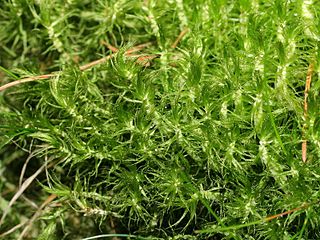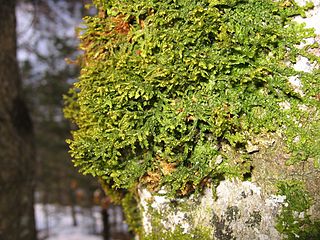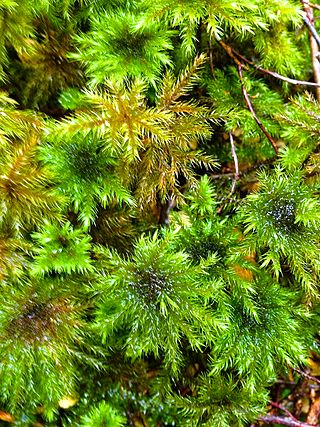
Funaria is a genus of approximately 210 species of moss. Funaria hygrometrica is the most common species. Funaria hygrometrica is called “cord moss” because of the twisted seta which is very hygroscopic and untwists when moist. The name is derived from the Latin word “funis”, meaning "a rope". In funaria root like structures called rhizoids are present.

Jungermanniaceae is the namesake family of leafy liverworts. It is a group of small plants that are widely distributed. Several genera formerly included within the family are now classified in the Myliaceae or Solenostomataceae.

Anthyllis is a genus of flowering plants in the family Fabaceae. This genus contains both herbaceous and shrubby species and is distributed in Europe, the Middle East and North Africa. The most widespread and familiar species is A. vulneraria, a familiar grassland flower which has also been introduced to New Zealand.

Dicranum is a genus of mosses, also called wind-blown mosses or fork mosses. These mosses form in densely packed clumps. Stems may fork, but do not branch. In general, upright stems will be single but packed together. Dicranum is distributed globally. In North America these are commonly found in Jack pine or Red pine stands.

Porella is a large, common, and widespread genus of liverworts in order Porellales. It is a member of the family Porellaceae within that order.

Plagiomnium affine, the many-fruited thyme-moss, is a species of thyme-moss found in old-growth boreal forests in North America, Europe and Asia, growing in moist, but not wet, basic to slightly acidic micro-habitats in woodland and in turf.

Marsupella is a liverwort genus in the family Gymnomitriaceae.

Gymnomitriaceae is a liverwort family in the order Jungermanniales.

Tortula is a genus of mosses in the family Pottiaceae.

Leucobryum is a genus of haplolepideous mosses (Dicranidae) in the family Leucobryaceae. The name comes from the Greek leukos, meaning white, and bryon, meaning moss.

Plagiomnium is a genus of mosses in the family Mniaceae. It was formerly a part of a more encompassing genus Mnium and in 1968 Finish bryologist Timo Juhani Koponen justified splitting the genus into a number of smaller genera.
Gigaspermum is a genus of moss in the family Gigaspermaceae. It contains four species.
Lophozia is a genus of liverworts belonging to the family Lophoziaceae.

Plagiothecium is a genus of moss belonging to the family Plagiotheciaceae. It has a cosmopolitan distribution.
Sphagnum platyphyllum, the flat-leaved bogmoss, is a species of moss belonging to the family Sphagnaceae.

Tetraplodon is a genus of mosses belonging to the family Splachnaceae.
Pylaisia is a genus of mosses belonging to the family Pylaisiaceae.

Hypnodendron is a genus of mosses belonging to the family Hypnodendraceae.

Plagiobryum is a genus of mosses belonging to the family Bryaceae. It has a cosmopolitan distribution.














